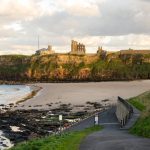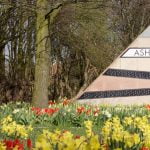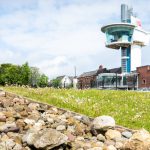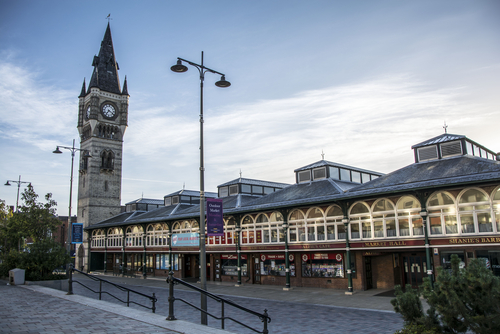
Darlington is a large market town in County Durham, in North East England. The town lies on the North Sea coast, about 16 miles (26 km) west of Middlesbrough, and 37 miles (59 km) south of Newcastle. The town comes under the jurisdiction of the Borough of Darlington, a unitary authority. The town is particularly famous for, along with Stockton, having the world’s first public railway line operating steam locomotives, i.e. the Darlington to Stockton railway. Throughout the region, the town is often referred to as ‘Darlo’.
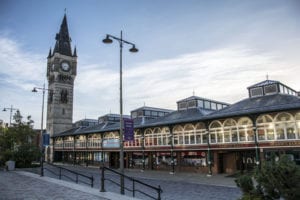
Image: s99/Shutterstock.com
Darlington A Fleeting History
The name Darlington derives from the Anglo-Saxon designation of ‘Dearthington’. This name translates to English as ‘the settlement of Deornoth’s people’. By Norman times, the town’s name had been shortened to Derlinton. Later, the name was to change again, as, throughout the 17th and 18th centuries, the town was referred to as Darnton.
Located on the banks of the River Skerne, a tributary of the River Tees, Darlington began out as an Anglo-Saxon settlement. In the 9th century, the invading Danes took over the area, which is evident from the many place names of Viking origin in the locality. In 1003, Dearthington, as it was then known, was gifted by Styr, the son of Ulphus, to the Community of St Cuthbert, in Durham.
In 1125, the Norman St. Andrew’s Church was built, which is now the oldest surviving building in the town. In 1183, the prominent St. Cuthbert’s Church was constructed. Today, a Grade I listed building, it is regarded as one of the most important early churches throughout the north of England.
It was around 1195 that Darlington came under the authority of Hugh Pudsey, the influential Bishop of Durham, quickly becoming a borough under his jurisdiction. It was during this time that the town’s medieval street layout was created, which is still evident in the likes of Skinnergate, Houndgate, Market Place, Horsemarket and High Row. However, at this time, the town only had a population of several hundred and was largely an agricultural settlement. Apart from farming, the only other industries in medieval Darlington were wool and leather making.
The Great Fire of Darlington
In May 1585, Darlington suffered a disastrous fire. In an era when almost all buildings were constructed of wood, with a thatched roof fire was a constant threat. In all, more than 270 houses were destroyed, and 800 people made homeless. However, the townsfolk quickly went on to rebuild. In 1597 and 1605, further disaster struck with serious outbreaks of the plague.
Visiting during the 18th century, celebrated author Daniel Defoe remarked on the town that it had “nothing remarkable but dirt”. However, it was during the 18th century that big changes were afoot in the town. For instance, in the 18th century, Darlington became well-known for the manufacture of linen. In 1772, the towns first local newspaper was published. The first bank in the town, Backhouse’s Bank of Darlington, was founded in 1774, by James Backhouse, a wealthy Quaker and local businessman. Backhouse’s Bank merged in 1896, with Gurney’s Bank of Norwich and Barclays of London and others, to form what is now Barclays Bank.
George Stephenson
On 27th September 1825, Locomotive No.1, manned by renowned inventor and railway engineer, George Stephenson, made its historic inaugural journey from Shildon to Stockton, via Darlington, to mark the official opening of the world’s first public railway to use steam locomotives. The line connected collieries near Shildon with Stockton-on-Tees and Darlington. The movement of coal to ships rapidly became a lucrative business, and the line was soon extended to the new port at Middlesbrough.
As local industry grew, prominent entrepreneurs began to make a significant investment in the town. In 1846, a water company was formed to supply piped water around the town. In the 1850s, a network of sewers was built, which greatly resolved the town’s sanitary problem. In 1853, South Park was totally redeveloped with financial backing from prominent local Quakers, the Backhouse family. In 1854, the Darlington Mechanics Institute was opened by another local eminent Quaker, Elizabeth Pease Nichol, who had made the largest donation to its building costs. In 1864, Darlington’s most famous landmark, the clock tower, was gifted to the town by the industrialist Joseph Pease. In 1885, a Library was opened, after funding by Edward Pease. Central Station was built in 1887.
Hopetown Carriage Works was established in 1853, and supplied carriages and locomotives to the Stockton and Darlington Railway. They were the first railway engineering company to set up in the town. By the early 20th century, the railway industry was a major employer in the town, as there were three major well-established companies and a number of smaller firms that were carrying out railway engineering and related works.
The town was granted a Royal Charter of Incorporation, on 1 October 1867, entitling it to have its own MP and Mayor.
Twentieth-century Darlington
While only a small market town at the beginning of the 1800s, Darlington’s population grew rapidly over the century, with the emergence of the industrial revolution and the corresponding availability of jobs. By 1900, the town’s population was around 50,000.
In 1900, electricity was first generated in Darlington. In 1903, the town’s horse-drawn trams were replaced by electric trams, which in turn, were replaced by buses in 1926. In 1915, the boundaries of Darlington were extended to include Faverdale and Branksome. And in 1932 they were extended again, to include Whinfield, Haughton, Lingfield and Firth Moor.
In the 1920s and 1930s, the town saw its first council houses built. Many more were constructed, following the end of WW2 in 1945.
The Modern Era
In the latter part of the 20th century, traditional manufacturing industries in Darlington began to decline. The early 1960’s saw the closure of all the town’s locomotive and wagon manufacturers, after more than 100 years of being a mainstay employer.
Nonetheless, the town continued to develop, as the Queen Street Centre was built in 1969, and Darlington Town Hall and the Sixth Form College, both opened in 1970. The Railway Museum in opened in 1975, Northgate House in 1976, the Arts Centre in 1982, the Dolphin Centre in 1983, the Cornmill Shopping Centre in 1992, and Eastbourne Sports Complex in 1999.
On 1 April 1997, the Borough of Darlington became a Unitary Authority, with the town of Darlington being both the main urban and administrative centre. The Borough is also home to the Durham Tess Valley Airport, of which it shares joint ownership with four other Tess Valley local authorities and one private company.
The local economy is now very much centred on the service sector, which is almost twice the size of its industrial and manufacturing base. Nevertheless, it has been recognised in recent years as having one of the fast-growing local economies in the UK. This is exemplified by the population being recorded as 105,564 in the most recent 2011 census.
Getting to Darlington
Road
If you are driving to Darlington, then there are two arterial roads that serve the town, the A66 and the A1(M). The transpennine A66 connects Darlington with nearby Stockton-on-Tees Middlesbrough to the east and Cumbria to the west. The A1(M) runs north to south, connecting Darlington with Newcastle and Scotland, via the A1, northwards, and with Leeds and most of the rest Yorkshire to the south.
Rail
Darlington railway station is an important interchange stop on the East Coast Main Line and has regular services to London Kings Cross, Leeds, Edinburgh, Manchester Piccadilly, Manchester Airport and Newcastle. The station also serves as the mainline interchange for Middlesbrough’s railway station. Darlington is also a station on the Tees Valley Line, connecting with all the main settlements of the Tees Valley between Bishop Auckland and Saltburn.
Bus
Arriva North East operate most of the bus services in and around the town. Although, two small scale operators; Dales & District and Scarlet Band, do operate a few routes. National Express operates an extensive intercity bus service to Darlington from all major towns and cities in the UK. Buses to and from Kings Cross in London are generally cheap and plentiful.
Airport
Durham Tees Valley Airport is only 7 miles (11 km) east of Darlington town centre. It has flights to and from several domestic locations and a few international flights to locations across Europe. The nearest large airport is Newcastle International Airport, about 42 miles (68 km). The journey should take about an hour by car or taxi and between 70 and 80 minutes by train.
Places to see In Darlington!
A suggestion of just a few of the places to see in Darlington are;
Raby castle
Raby Castle is one of the best-preserved medieval fortresses in the UK. Set in rolling parkland and sculpted gardens, the castle has been meticulously restored, reflecting its status as a living home. The castle’s interior has Medieval, Regency and Victorian themes, plus one of the best private art collections in the country. The splendid gardens are landscaped in a traditional Regency and Victorian fashion, while the Coach House has a collection of antique carriages.
‘Head of Steam’ Darlington Railway Museum
Darlington’s railway history is recounted at the museum, which is located at North Road station, on the route of the Stockton and Darlington Railway. The museum tells the story of the rail industry in the town, and the story of the Stockton Darlington Railway. On view is George Stephenson’s Locomotion No. 1, which pulled the first train on the line in September 1825. There are also three other locomotives on display, the newest dating to 1919. There’s also a highly detailed Stockton and Darlington Railway model, interactive exhibits, and restored period architecture.
St Cuthbert’s Church
One of the most significant Medieval churches in the North of England, St Cuthbert’s construction started 1180 and took about 60 years to complete. The font is made of Frosterley marble dating back to 1375. The oak cover, carved in 1662, is the tallest on any font in the country. The nave roof has oak beams that date back to the 13th century. From the same period is a contemporary stone depiction of Henry III, who visited Darlington in 1260. The church is open every day for visitors from 11:00 to 13:00 between Easter and September.
Things to do!
A couple of things to do are:
Walworth Castle Birds of Prey
The Grade I-listed 16th-century Walworth Castle is a stately mansion built in the 16th century to resemble a Medieval castle. The Castle was a prisoner of war camp in WWII and has been a boarding school, but is now a hotel. On the grounds, there is a nature preserve for birds of prey, which you can visit from Friday to Monday. There are aviaries with a variety of falcons, hawks and owls on view. There are also flying displays (two are scheduled each day), as well as the opportunity for interactive encounters with the birds and falconry courses.
Drinkfield Marsh Nature Reserve
Where to stay?
Indicative prices for the commonly available types of accommodation, in and around Darlington, for two people sharing, are as follows:
Luxury Hotel: £80 – £140
Basic Hotel: £45 – £80
Travel Lodge/B & B: £35 – £60
The Darlington Quiz
Quiz Maker – powered by Riddle
So there you have it our Five Minute Overview of Darlington and a quick quiz to see if you were paying attention! Before you go why not try some of our other quizzes or have a look at some of our other location guides. better still why not join our growing community it’s free and could be very rewarding going forward.



